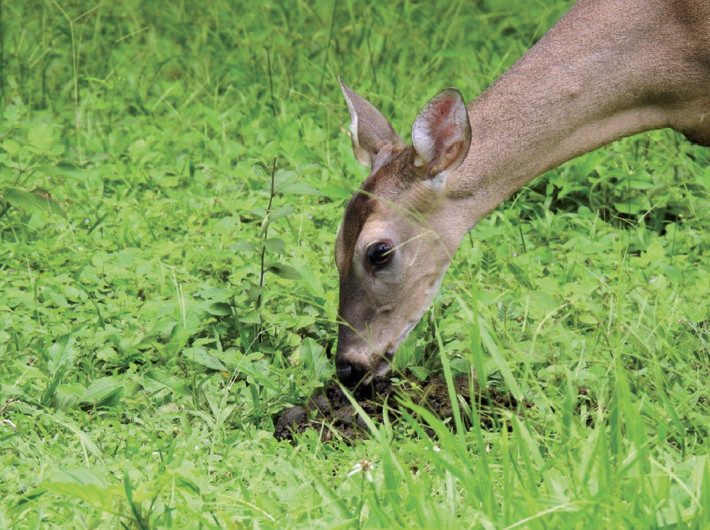Heterospecific coprophagy in the white-tailed deer Odocoileus virginianus (Zimmermann, 1780) in Costa Rica
DOI:
https://doi.org/10.31687/SaremNMS25.1168Keywords:
Cervidae, coprophagy, dry forest, feces, herbivorous, horsesAbstract
Animals may engage in coprophagy, including heterospecific coprophagy, where they consume the feces of other species. The white-tailed deer, Odocoileus virginianus, primarily feeds on plant material, such as tender forbs and shrub shoots. This report documents a case of heterospecific coprophagy by the white-tailed deer in Costa Rica, where two individuals were observed consuming domestic horse feces. The reasons for heterospecific coprophagy in ruminants like the white-tailed deer are unclear. Nutritional supplementation, microbial transfer, or other ecological factors may play a role in this behavior. However, such a behavior also poses risks, including the transmission of diseases and parasites from other species.
References
Bo, T. B., X. Y. Zhang, K. D. Kohl, J. Wen, S. J. Tian, & D. H. Wang. 2020. Coprophagy prevention alters microbiome, metabolism, neurochemistry, and cognitive behavior in a small mammal. The ISME Journal 14:2625–2645. https://doi.org/10.1038/s41396-020-0711-6.
Di Mare, M. I. 1991. Food habits of an insular Neotropical population of white-tailed deer. Applied Animal Behaviour Science 29:507. https://doi.org/10.1016/0168-1591(91)90278-6.
Di Mare, M. I. 1994. Hábitos alimentarios del venado cola blanca en la Isla San Lucas, Puntarenas, Costa Rica. Ecología y manejo del venado cola blanca en México y Costa Rica (C. Vaughan & M. Rodríguez, eds.). EUNA, Heredia.
Fish, K. D., M. L. Sauther, J. E. Loudon, & F. P. Cuozzo. 2007. Coprophagy by wild ring-tailed lemurs (Lemur catta) in human-disturbed locations adjacent to the Beza Mahafaly Special Reserve, Madagascar. American Journal of Primatology 69:713–718. https://doi.org/10.1002/ajp.20392.
González-Jáuregui, M., J. P. Esparza-Carlos, & M. F. Barber Mir. 2021. Heterospecific coprophagy: turkey vulture (Cathartes aura) feeding on cougar (Puma concolor) feces. Western North American Naturalist 81:626–629. https://doi.org/10.3398/064.081.0415.
Hirakawa, H. 2001. Coprophagy in leporids and other mammalian herbivores. Mammal Review 31:61–80. https://doi.org/10.1046/j.1365-2907.2001.00079.x.
Hart, B. L., L. A. Hart, A. P. Thigpen, A. Tran, & M. J. Bain. 2018. The paradox of canine conspecific coprophagy. Veterinary Medicine and Science 4:106–114. https://doi.org/10.1002/vms3.92.
Holdridge, L. R. 1967. Life Zone Ecology. Tropical Science Center, San José.
Janzen, D. H. 1981. Enterolobium cyclocarpum seed passage rate and survival in horses, Costa Rican Pleistocene seed dispersal agents. Ecology 62:593–601. https://doi.org/10.2307/1937726.
Janzen, D. H. 1982a. Natural history of guacimo fruits (Sterculiaceae: Guazuma ulmifolia) with respect to consumption by large mammals. American Journal of Botany 69:1240–1250. https://doi.org/10.1002/j.1537-2197.1982.tb13369.x.
Janzen, D. H. 1982b. How and why horses open Crescentia alata fruits. Biotropica 14:149–152. https://doi.org/10.2307/2387746.
Karasov, W. H. & H. V. Carey. 2009. Metabolic teamwork between gut microbes and hosts. Microbe 4:323–328.
Körner, M., J. M. C., Diehl, & J. Meunier. 2016. Growing up with feces: benefits of allo-coprophagy in families of the European earwig. Behavioral Ecology 27:1775–1781. https://doi.org/10.1093/beheco/arw113.
Krief, S., A., Jamart, & C. M. Hladik. 2004. On the possible adaptive value of coprophagy in free-ranging chimpanzees. Primates 45:141–145. https://doi.org/10.1007/s10329-003-0074-4.
Leggett, K. 2004. Coprophagy and unusual thermoregulatory behaviour in desert dwelling elephants of North-Western Namibia. Pachyderm 36:113–115.
Magliocca, F., S. Quérouil, & A. Gautier-Hion. 2003. Seed eating in elephant dung by two large mammals in the Congo Republic. Revue d'Écologie 58:143–149. https://doi.org/10.3406/revec.2003.5307.
Mattioli, S. 2011. Family Cervidae (Deer). Handbook of the mammals of the world, Vol. 2: Hoofed mammals (D. E. Wilson & R. A. Mittermeier, eds.). Lynx Edicions, Barcelona.
Meyer, M., J. Hummel, & M. Clauss. 2010. The relationship between forage cell wall content and voluntary food intake in mammalian herbivores. Mammal Review 40:221–245. https://doi.org/10.1111/j.1365-2907.2010.00161.x.
Miller, M. W., & E. S. Williams. 2003. Horizontal prion transmission in mule deer. Nature 425:35–36. https://doi.org/10.1038/425035a.
Molinari, J. 2007. Variación geográfica en los venados de cola blanca (Cervidae, Odocoileus) de Venezuela, con énfasis en O. margaritae, la especie enana de la Isla de Margarita. Memoria de la Fundación La Salle de Ciencias Naturales 167:29–72.
Mora, J. L., E. Blasco, A. García-Serrano, & J. Herrero. 2024. Iberian wild goat coprophagy on dove guano. A case report and insights from food analysis. Food Webs 40:e00353. https://doi.org/10.1016/j.fooweb.2024.e00353.
Mora, J. M. 2000. Mamíferos silvestres de Costa Rica. Editorial Universidad Estatal a Distancia, San José.
Morera, B., V. Montalvo, C. Sáenz-Bolaños, J. C. Cruz-Díaz, T. K. Fuller, & E. Carrillo. 2022. Osteophagia of sea turtle bones by white-tailed deer (Odocoileus virginianus) in Santa Rosa National Park, northwestern Costa Rica. Neotropical Biology and Conservation 17:143–149. https://doi.org/10.3897/neotropical.17.e87274.
Morera, B., et al. 2023. Spatiotemporal effects of free-roaming horses on white-tailed deer distribution in Northwestern Costa Rica. Rangeland Ecology & Management 86:80–86. https://doi.org/10.1016/j.rama.2022.11.002.
Mouele, A. M., S. Brogan, & C. Stephan. 2022. Allo-and autocoprophagy events in wild western lowland gorillas (Gorilla gorilla gorilla). African Journal of Ecology 60:1329–1333. https://doi.org/10.1111/aje.13003.
Nishikawa, M., & K. Mochida. 2010. Coprophagy-related interspecific nocturnal interactions between Japanese macaques (Macaca fuscata yakui) and sika deer (Cervus nippon yakushimae). Primates 51:95–99. https://doi.org/10.1007/s10329-009-0182-x.
Ranade, S. P., & Prakash, V. (2015). Coprophagy by barking deer Muntiacus vaginalis (Mammalia: Cetartiodactyla: Cervidae) in Buxa Tiger Reserve, West Bengal, India. Journal of Threatened Taxa 7:7825–7826. https://doi.org/10.11609/jott.o4367.7825-6.
Rodríguez, M. A. 2015. El venado cola blanca en el bosque seco tropical de Costa Rica. Windmills International Editions Inc., California.
Rodríguez-Ramírez, M., & J. M. Mora. 2022. Analysis of the male annual antler cycle, reproductive behavior and spotted fawn presence in the tropical white-tailed deer. Therya 13:143–151. https://doi.org/10.12933/therya-22-1158.
Soave, O., & C. D. Brand. 1991. Coprophagy in animals: a review. The Cornell Veterinarian 81:357–364.
Spitzer, R., et al. 2023. Coprophagy in moose: a first observation. Ecology and Evolution 13:e9757. https://doi.org/10.1002/ece3.9757.
van der Wal, R., & M. J. J. E. Loonen. 1998. Goose droppings as food for reindeer. Canadian Journal of Zoology 76:1117–1122. https://doi.org/10.1139/z98-033.
Waggershauser, C. N., P. Taberlet, E. Coissac, K. Kortland, C. Hambly, & X. Lambin. 2022. Interspecific coprophagia by wild red foxes: DNA metabarcoding reveals a potentially widespread form of commensalism among animals. Ecology and Evolution 12:e9029. https://doi.org/10.1002/ece3.9029.

Downloads
Published
How to Cite
Issue
Section
License
Copyright (c) 2025 José Manuel Mora, Juan de Dios Astorga-Acuña

This work is licensed under a Creative Commons Attribution-NonCommercial 4.0 International License.

